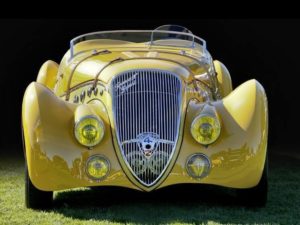Following a conversation with someone who is currently restoring a FIAT 500 and a Chrysler Saratoga - that goes pretty well together, the parts are still different - we hereby extract a chapter from the - limited availability, see the box on the right of the site - AMK Car Care Special at.
With that lover of dwarfs and giants we talked about thermal and cellulose lacquer.
At the end of the story you can see that the pain is there ... And the car care specialist also contains a lot of technical, historical and practical information about cherishing your classic car.
Car paints have been around as long as there are cars. Only the way they are made - and applied - has changed just as much over the years as the cars themselves. We look back on 120 years of car paint history and see what we can do with that now.

This traditional approach did not fit in with the mass production that was starting. In Germany, car manufacturers made passenger cars in 1901 845. Nine years later there were 12.000.
The paint process had to be able to keep up with that production. The oil-based lacquers were improved and the drying times were shortened by increasing the temperature. But in 1910, car paint was not dry until after three weeks. The end of vegetable oil-based paints came with the birth of Ford's Model T. Ford wanted to turn it into 1.000 every day. That was no problem thanks to the production line. But with an 20 day drying time of the paint, he would need a conveyor belt of 100 kilometer length.

After the first world war, technology went ahead with leaps and bounds. The arms industry had made huge quantities of nitro cellulose powder worldwide. The idea was to do something peaceful with it in one way or another. One of the results from that revenue-oriented thinking was the cellulose lacquer. There were few solids in the product and it had little gloss. That is why it had to be applied in several thin layers. Then it had to be polished - polished - to shine. Brushing was still a lot of work, but it already saved considerable time and there was more choice in colors from that moment on. Until 1930, cellulose lacquer was the norm for all car manufacturers.

It was also the birth time of the 'effect lacquers\ '. First, ground fish scales were mixed by varnish for that unique color experience. What is now 'silver metallic' was first called 'fish silver paint'.

But most cars left the assembly line in a further developed synthetic resin lacquer. The addition of melamine resins thereby increased hardness and gloss and improved the service life of the paint layer. The end point in this evolutionary trajectory is the two-component synthetic resin lacquers, which were customary up to the last century, whereby the profit lies mainly in processing. In the 1990s, the water-based paints started their rise. Water takes over there in the function of the solvent and the development was controlled for environmental reasons. There was only an ever smaller fraction of diluents and solvents from the petroleum range. The actual breakthrough of the water-based varnishes was based on the law. Since January 2007, the share of solvents per liter of base coat may not exceed 420 grams. Most manufacturers are now around the 100 gram. The keyword in that story is 'base lacquer'. The transparent or cover layer with which the water-based varnish must be 'sealed' is, as usual, a solvent-containing acrylic varnish. And that is precisely why the water-based varnish in terms of hardness, gloss and ease of brushing cannot match the old faithful synthetic two-component (2K) varnish.
This has brought us right into our current classic world. Because acrylic lacquers are still available without any problems. Even despite the fact that they are almost no longer used as a base coat for new cars. But even if a delivery problem for acrylic lacquer should arise in the future, we do not have to worry about it. The properties of 2K and water-based paints do not differ much. They do not bite each other, and that is important in the (partial) restoration of a classic. That 'biting' is a point when the original lacquer layer is a cellulose nitro lacquer as it was often used in the fifties and England or if there is a show-shine & sale spray job from the States. Dynamic sales overblowing with a more modern paint can have a dramatic effect on an old 'thermal' paint layer from a GM mastodon. Then there is only ee
But how can you determine what kind of lacquer layer is on a classic? The simplest test is best: rub it over with a cloth moistened with nitrobenzene (industrial thinner). A cellulose nitrate lacquer colors the cloth immediately and clearly and it becomes sticky. Thermoplastic acrylic lacquer reacts the same.
And to definitively decide which of the two types is involved, you have to let a sanding disc smell the paint. Cellulose lacquer then disappears into a cloud of dust, TPA (thermoplastic acrylic lacquer) melts and allows the sanding disc to 'fill up'. That TPA can even become softer again due to the heat of the sun or (the hood) engine heat. That is why it can never be repainted carefree with a 2K lacquer (which often happens with USA 'sales spraying'). 'Isolating' the old lacquer layer with a special primer is fine. But costs extra.

When we talk about the restoration of vehicles from the first half of the 'twenties', it can usually still be done with the original paints. The availability of the 'binder' for cellulose lacquers is now a problem. Master sprayer Theo Terwel from Vorden has searched all the way to China. But nothing found.


